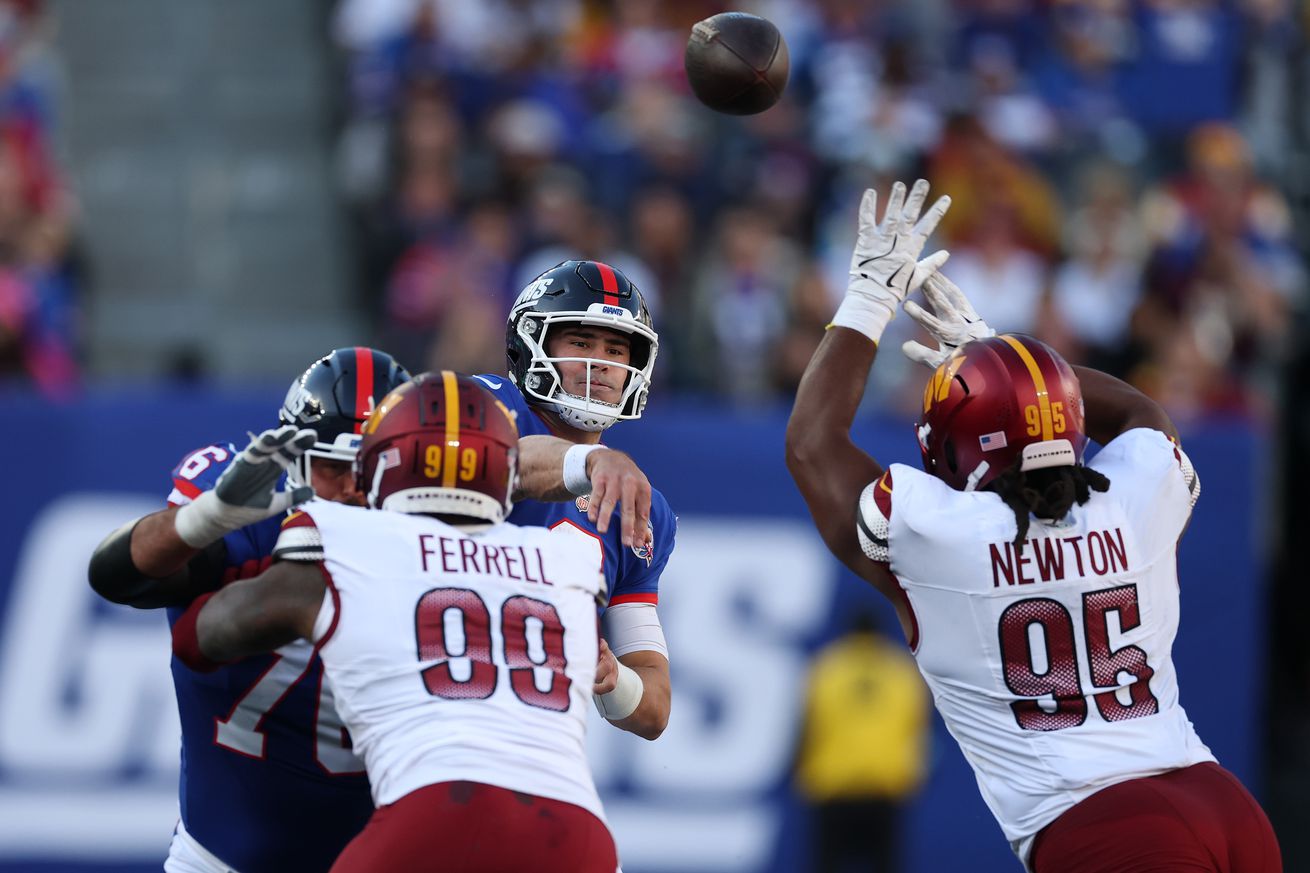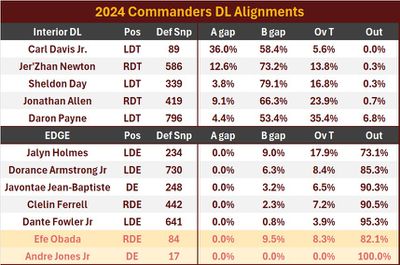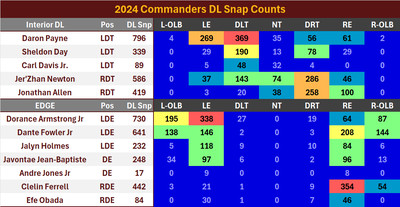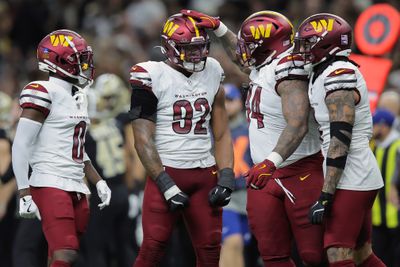
Examining the weakest part of Washington’s unexpectedly strong game: Part 2 of 4
Heading into the second off-season of Adam Peters’ rebuild, the Commanders’ biggest issues to address were on defense, and in particular, a rushing defense that gave up the fifth highest average gain (4.8 Y/A) and allowed the 9th highest opponent success rate and the 6th highest EPA/rushing attempt.
The Commanders made a number of moves in free agency to get bigger along defensive front, while releasing some key defensive players. The big questions heading into training camp are whether the right moves were made to strengthen the running defense and to make up for the loss of production of the departing starters.
The defensive front received the most attention of any unit on the team in free agency, with the release of starters Jonathan Allen and Dante Fowler and the addition of DT Javon Kinlaw, NT Eddie Goldman, and Edge Defenders Von Miller, Deatrich Wise Jr. and DE Jacob Martin.
The first edition of this four part series asked which running gaps were most successful for opposing running backs in 2024. That analysis showed that the Commanders had a particular weakness at stopping runs around the left end of the offensive line, corresponding to the right end of the defensive line. The rushing defense was also weak along most interior gaps, particularly the A gaps and left B gap.
This article will take a look at where the Commanders’ defensive linemen took snaps, and how that might relate to the strengths and weaknesses of the rushing defense. The final two articles will take a look at productivity stats of the defensive linemen to see how the returning players stack up and how the new additions compare to the players who were released.
2024 DL Alignments
The following table shows where the Commanders’ defensive linemen and outside linebacker Dante Fowler Jr lined up relative to the OL gaps. Players are listed in order of the proportion of time spent at interior gaps (top) vs on the edge (bottom).

Interior Defenders
Carl Davis Jr. was the Commanders’ nose tackle, and played the highest proportion of snaps in the A gaps of any of Washington’s defenders. He played the least of any of the interior defensive linemen, but made important contributions to stopping the run when he was on the field.
Rookie Jer’Zhan “Johnny” Newton played the second most snaps of Washington’s interior defenders. Newton is a somwhat smaller (6’2”, 304 lbs), gap shooting defender. The first surprise for me was that he second most interior-oriented of the iDL, aligning in A or B gaps on 85.8% of defensive snaps, and only taking 14.1% of snaps at edge alignments.
Journeyman Sheldon Day was a rotational piece on the DL. He aligned predominantly in the B gaps, but split out over the offensive tackles on 16.8% of snaps.
Jonathan Allen was slated to be the starting Right Defensive Tackle, but missed 9 games with a torn pec. Unlike the players listed before him, Allen did not have an even split of playing time between rushing and passing downs. Allen played 41% of his snaps in run defense and 59% in pass defense. He played 75% of snaps aligned on the interior, predominantly in the B gaps, but also spent a healthy 24.6% of snaps at edge alignments, mainly over the OT.
Daron Payne got the most playing time of any of Washington’s defensive linemen. Some readers might be surprised to learn that he also spent the most snaps of any of the interior linemen aligned at Defensive End. He took the most snaps aligned as a 3-tech DT in the B gaps, but spent 35.4% of snaps aligned as a 5-tech over the OT and 6.8% of snaps out further on the edge. Similar to Allen, Payne played 60% of snaps in pass defense and 40% in run defense.
Edge Defenders
Jalyn Holmes was a mid-season addition in 2024, signed mid-week as an emergency replacement when Jonathan Allen and Javontae Jean-Baptiste were injured against the Ravens. He has played for 5 teams in his 7 year career, splitting time between DE and iDL. He is listed as a DT in the Commanders’ depth chart. But he played predominantly at edge alignments, outside of the OT. He did play 9% of snaps at 3-tech, which was the most interior snaps of any of the edge defenders.
Dorance Armstrong played the most of any DE and the second most snaps on the Commanders’ DL. He took a small proportion of defensive snaps aligned in the B gaps and as a 5-technique on the OT’s shoulder. Like the rest of Washington’s Edge Defenders, aside from Jalyn Holmes, he predominantly aligned outside the tackles (‘Out’), in the C and D gaps. Armstrong took 38% of his defensive snaps standing up on the edge as an Outside Linebacker (OLB).
Clelin Ferrell took the most snaps at DE opposite from Armstrong, but missed time due to a nagging knee injury suffered in the season opener in Tampa. He played in similar gap alignments to rookie Javontae Jean-Baptiste. Ferrell and JJB took even fewer snaps than Armstrong on the interior and at 5-tech, with over 90% of snaps outside of the tackles. Both of these two spent less time at OLB than Armstrong (Ferrell 12.9%, Jean-Baptiste 18.9%).
Dante Fowler was originally signed to be a situational pass rusher, but got more playing time than expected when he was asked to fill in for injured starting RDE Clelin Ferrell. He was listed in the team’s depth chart as an OLB. He ended up playing the second most snaps of the Edge Defenders, and played the most of anyone at OLB. But he actually played more snaps as a down lineman, with a 56:43 split between snaps with his hand in the dirt and standing up. Fowler spent the highest proportion of snaps outside the tackles of any of Washington’s defensive linemen.
2024 Snap Counts by Position
Now, let’s take a look at where on the field the players lined up and how that matched up with strengths and weaknesses in run defense.
The previous article showed that the Commanders had a glaring weakness defending runs around the left end (LE; right DL), which opponents exploited. They were also weak defending the run through interior gaps, particularly the A gaps and left B gap. And they were relatively strong against runs around the right end and left C gap. The biggest issue at LE is suggestive of a weakness at setting edge on the right side of the DL. Jet sweeps and reverses around both ends were also particularly effective, but represented such a small proportion of the total sample that they are hard to analyze meaningfully.
Of course, defending the run is a whole team effort. The DL plays a large part, but the linebackers have a major role to play as well, and even the secondary. Joe Whitt Jr. has attributed some of the weakness defending the run to loss of his third linebacker, when rookie Jordan Magee was injured in the preseason. Nevertheless, the DL is the first line of defense at the point of attack, and plays a critical role in stopping the run and setting up the second level defenders. So a look at who played where is likely to be informative.
The following graph is a heat map of defensive snaps by position on the DL. The color scale indicates proportion of the maximum snap count (Max: 369 snaps, Daron Payne at Left Defensive Tackle). In this representation, players are listed in order of the proportion of snaps spent from the left to the right side of the formation. I have given them ‘Left’ and ‘Right’ designations when they spent substantially more time on one side.

Biggest Weakness – Left End of OL/Right DL
The glaring weakness in the Commanders’ run defense was vulnerability to runs outside of the TE around the left end of the offensive line, where opposing RBs averaged 7.95 Y/Att and 3.65 YBC/Att. This is the gap manned by the Right Defensive End (RDE) in the Commanders’ defense.
The designated starting RDE for the Commanders in 2024 was Clelin Ferrell. Ferrell missed three games to injury early on the season and played sparingly in four games toward the end of the season, including the Wild Card game. Overall, Ferrell played 35% of the DEs’ total snaps at right edge.
Ferrell was assisted at RDE and backed up when absent by Dante Fowler Jr. Fowler moved around the formation, spending 55% of his DL snaps on the right edge and 45% on the left edge. Fowler accounted for 30.2% of the DEs’ snaps at right edge.
The rest of the teams snaps at RDE were covered by a platoon of players, including Dorance Armstrong (13%), Javontae Jean-Baptiste (9.4%), and Jalyn Holmes (7.7%). While a few of the DTs also took snaps at DE, when they did they mainly lined up over the OT (5-tech), not outside the TE. Daron Payne took the most snaps lined up outside on the edge, but those snaps were mainly taken on the left side of the line.
With this coarse level of analysis, it is difficult to pinpoint the weakness in run defense to the level of individual DEs. The primary suspects are narrowed down to Clelin Ferrell and Dante Fowler. But it is possible that opponents made their biggest gains during the 35% of snaps when DE was manned by other players.
Biggest Strengths – Right End of OL, Left C Gap
The Commanders were strongest at defending runs around the right end of the offensive line, holding opposing RBs to just 2.8 Y/A and 0.58 YBC/Att. That gap was primarily defended by the Left Defensive End (LDE). The primary starter at LDE was Dorance Armstrong, who took 47% of the DE group’s total snaps on the left edge. Armstrong was backed up and assisted by Dante Fowler (25% of LDE snaps), Javontae Jean-Baptiste (11.5%), and Jalyn Holmes (10.8%). DT Daron Payne also played 54 defensive snaps outside the OT at DE, most of which would have been on the left side.
The Commanders were also strong at defending runs through left C gap, outside the left OT, holding opposing backs to 3.52 Y/A and just 0.52 YBC/Att. While you might think the C gaps are defended by the DEs, in Joe Whitt Jr’s defense, they were predominantly the responsibility of the DTs, playing 5-tech. The main suspects who might deserve credit for the strong C gap defense on the right side were Johnny Newton and Jonathan Allen.
Other OL Gaps
The interior run defense was a bit of a mixed bag, but overall unimpressive.
The next weakest point in run defense, after the left end, was the left B gap, where opponents averaged 5.59 Y/A and 2.91 YBC/Att. This gap is immediately adjacent to the left C gap, where the run defense was strong, and was defended by the same players. There is no obvious explanation in terms of DL personnel for difference between these two gaps. Of the two main DTs playing these gaps, Johnny Newton spent slightly more time in the B gap and Jonathan spent more playing 5-tech in the C gap. But that small difference is unlikely to account for the huge disparity in run defense between these gaps.
The Commanders allowed over 5 Y/A and 2 YBC/Att through both of the A gaps. The middle of the OL was a shared responsibility of the entire DT group. The player who took the most snaps lined up in the A gaps was Johnny Newton (74 snaps). Jonathan Allen (38 snaps), Daron Payne (35 snaps) and Carl Davis Jr. (32 snaps) all spent roughly equal time over center or in the A gaps. So, it is difficult to point the finger at any single player. Overall, the Commanders’ DTs spent relatively little time aligned over center, so the A gaps were predominantly defended by interior linemen two-gapping from 3-tech alignments. Of the Commanders’ iDL, only Daron Payne and Carl Davis are really built for two-gapping. So that might have contributed to the softness in the middle.
Opposing backs had a slightly harder time on the right side of their lines, averaging just 4.39 Y/A and 1.90 YBC/Att through the right B gap, and 4.63 Y/A and 1.88 YBC/Att through the right C gap. These gaps were predominantly patrolled by Daron Payne, who has been the strongest run defender on the interior throughout his time in Washington. Payne was backed up at left DT by Sheldon Day (190 snaps), Johnny Newton (143 snaps) and Carl Davis Jr (48 snaps).

Photo by Jonathan Bachman/Getty Images
CONCLUSIONS
Mapping defensive alignments against strengths and weaknesses of the run defense is merely correlative and doesn’t really prove anything. However, some obvious associations stood out and seem to point to who were the strongest and weakest run defenders on the DL.
- The biggest weakness in run defense was on the right end of the DL, which was primarily manned by the duo of Clelin Ferrell (35% of right ED snaps) and Dante Fowler (30% of right ED snaps). They were mainly supported by a combination of Jalyn Holmes, Javontae Jean Baptiste and Efe Obada.
- The strongest point in run defense was the left end of the DL, where Dorance Armstrong was the primary starter, with help from Dante Fowler, Jalyn Holmes and JJB.
- The right interior, manned by a tag team of Johnny Newton and Jonathan Allen, was also weak. But the same players seemed to provide strong run defense in the offense’s left C gap.
- The left interior, defended by Daron Payne, supported by Sheldon Day and Johnny Newton, was stronger than the right interior.
